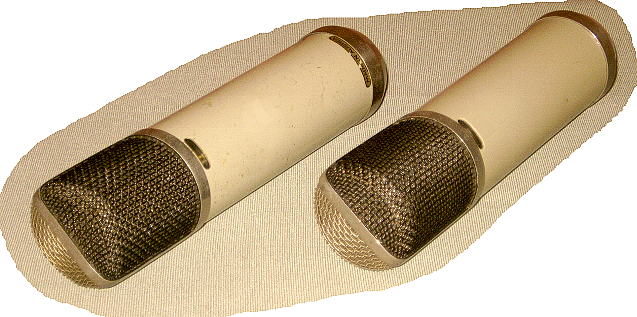----------
|
Curio's - Elam microphones ? |

|
|
|
|
Who made, the original, "Elam" microphones ? |
|
In the early days of valve microphone production, AKG and other manufacturers, had no means of distribution, especially in the area of export, and relied heavily, if not exclusively, on selling their products under larger company names e.g. Philips, Siemens and Telefunken. Therefore, many microphones, "Badged" by the distributor, were actually produced by manufactures such as AKG. |
|
The original "Elam" microphones, were manufactured by AKG. The name/title "Elam", being derived from the design title e.g. ela M250. Sometimes being called the Elam M250 etc. These, with other microphones from AKG, were normally distributed and therefore "badged", by Telefunken. |
|
Alas many Neumann and Schoeps microphones can also be found with the "Telefunken" badge. Examples being the Neumann U47 and Schoeps M221. Telefunken did not manufacture the the U47 or the M221, they only distributed them on behalf of Neumann and Schoeps, etc, with the agreed legal right to put their "Telefunken" badge on the microphone and associated parts. The so called Telefunken models might be rarer, but they are electrically and sonically identical to the "Legitimate" manufacturers own models, who made them in the first place ! |
|
Note - The "Telefunken" ela M250, is not to be confused with the Neumann M250. The later being an RF (Radio Frequency) proof version of the famous Neumann M50 valve microphone, with a different connector and earthing arrangement,. |
|
|
|
M250/251 series ..... |
|
The most famous "Elam" microphones, must be the M250/251 series. Their design was based around the famous "Original" CK12 capsule, but wired differently to that in the C12. As mentioned above, these units were manufactured by AKG and distributed, and therefore badged, by Telefunken. The type number could be suffixed by the letter "E". This means that model was designed for "Export" and uses a different type of valve. The "Standard" M250/251's were designed around the Telefunken AC701k valve, which were only readily available at that time, in central Europe. To take sales of this microphone into other areas of the globe, it was required to design a pre-amp / impedance converter, that was based around a valve that was more readily available in other parts of the world. Therefore, the "E" models used a plug in valve, namely the American 6072, rather then the "Continental" or "European" hard wired Telefunken AC701k. Of course, their performance is quite different. |
|
At this stage, I would like to point out that the suffix of an "E" is not used on the rarest of Telefunken microphones i.e. the "Stereo" ela M270. Alas the M270 uses a 6072 type valve, just like the M250E/251E (the M250/M251 use the AC701 type valve) ..... most misleading. Having never seen an M270, I had always assumed that it used a pair of AC701's, as you might expect from the model number. So, as the M270 uses the 6072 type valve, why not suffix the microphone model type with an "E" i.e. M270E. This would have been a far more sensible approach, following the Telefunken standard of model numbering. |
|
Note - Much literature on Telefunken microphones is not very precise re the use of different valve types and the need to use the "E" suffix ! |
|
Back to the M250/M251 series, The electronics of the Ela M250/251 series, are "Standardized" to the valve type used and housed in a large diameter perspex cylinder. This was all part of an idea by AKG’s design team, which enables the microphone to be easily dismantled into "Changeable" sections. The idea being that you could dismantle the microphone down to the basic level of "Sections", and replace them without the use of any tools. Quite a novel idea, however, it must have been quite expensive to keep a selection of spare parts (sections) in stock, rather then just single components. This perspex cylinder, encasing the electronics, proved to be very fragile. The screws and there captive nuts, that hold the two halves of the cylinder together, only act as "Crushers" if over tightened. Therefore when changing a valve etc, on these delicate units, take great care not to over tighten the fixing screws. When considering the 250E and 251E, using the 6072 valve, with all the space available, it seems a shame, that a larger audio transformer was not used, such as that used in the early AKG C12, type V2148. This would have given the microphone such a wonderful increase in LF "Dynamics". However, the smaller T14/1 transformer and together with a 0.5uF, coupling capacitor, were used instead. A modification is available, this enables an "Increase" the LF performance of the microphone, which it well deserves. |
|
|
| M260/261 series ..... |
|
AKG also manufactured the Telefunken badged Ela M260 & M261 microphones, these were "Cosmetically" similar to the AKG C28. However, the electronics were based around the AC701k valve. This would keep the electronics of the M260/261 much quieter then that of the C28, using the 6072 (12AY7) type valve. The size of the M260/261, is similar to that of the C28, however the diameter is more like that of the "Slender" C60/C61 i.e. Just 21mm. The M260 used the CK28 (Cardioid) type capsule, with the option of using extension tubes. Whilst the M261 used a multi-pattern capsule, offering Omni, Cardioid and Fig’8. |
|
|
| Currently (2009) |
|
"Telefunken of North America", are now manufacturing a selection of microphones that were originally manufactured by AKG/Neumann etc, and distributed under the "Telefunken" brand name. |